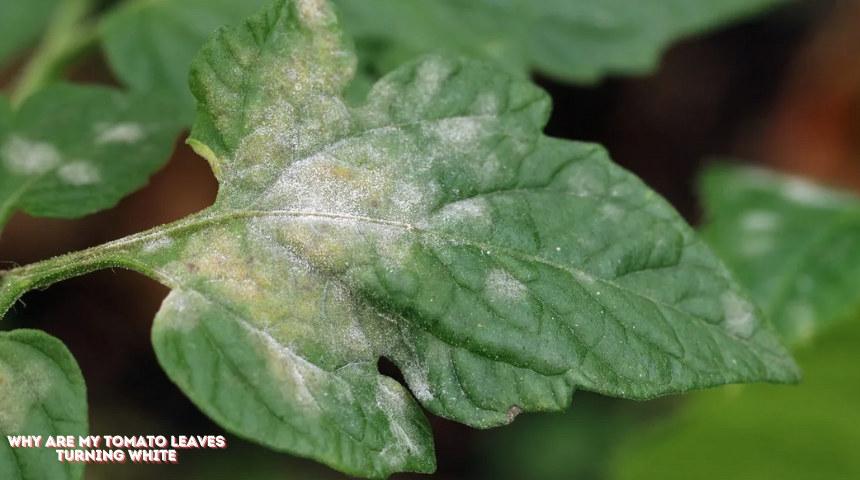As a gardener, I often get asked, “Why are my tomato leaves turning white?” This can be concerning, especially when you’ve put in so much effort. The good news is that it’s usually fixable with the right approach.
Sometimes, it’s due to sunscald, where the intense sun damages the leaves. Other times, it could be pests or a fungal issue like powdery mildew.
I always recommend checking the environment first. Is it too hot? Is there enough water? In my experience, making small adjustments can often turn things around quickly. Don’t panic—your tomatoes can bounce back with care.
Why Are My Tomato Leaves Turning White?
Your tomato leaves might be turning white for a few reasons. Sunscald is a common issue. When tomatoes are exposed to too much direct sunlight, the leaves can bleach out.
I’ve also seen powdery mildew cause this problem. It’s a fungal disease that leaves a white, powdery coating on the leaves. Another possible cause is nutrient deficiency, particularly a lack of calcium or magnesium.

Sometimes, pests like spider mites can also lead to white spots. I recommend checking your garden’s environment. Adjusting sunlight exposure or treating for pests might help. Always keep an eye on your plants and act quickly.
Here’s an expanded explanation for each of the 10 reasons why tomato leaves might turn white:
1. Sunscald: Tomato leaves are sensitive to sudden changes in sunlight exposure. If you’ve recently pruned your plants or if they’ve suddenly lost shade, the intense sunlight can cause sunscald
This leads to bleaching or white patches on the leaves, especially on those directly exposed to the sun. It’s most common in hot, sunny climates where the sun’s rays are strongest.

2. Powdery Mildew: This is a common fungal disease that affects many plants, including tomatoes. It thrives in warm, dry conditions and shows up as a white, powdery substance on the surface of the leaves.
If left untreated, it can spread quickly, covering the entire leaf and eventually causing it to wilt and die. Humid environments with poor air circulation are particularly susceptible to powdery mildew.
3. Nutrient Deficiency: Tomatoes require a balanced diet of nutrients to thrive. A deficiency in key nutrients like calcium or magnesium can cause the leaves to turn white or develop white spots.
Calcium deficiency often results in blossom end rot, while magnesium deficiency causes interveinal chlorosis, where the tissue between the veins of the leaves turns pale.
4. Pesticide Damage: Using pesticides incorrectly, such as applying them during the heat of the day or using a too-strong concentration, can lead to leaf burn.
The chemicals in the pesticides can cause the leaves to turn white or develop white spots as they react to the damage. It’s important to follow the instructions carefully and apply pesticides during cooler parts of the day.
Both extremes can lead to white spots or patches on the leaves as the plant struggles to maintain its health. It’s crucial to water your tomatoes consistently and deeply, especially during dry spells.
6. Chemical Drift: Herbicides and other chemicals used in nearby gardens or fields can drift onto your tomato plants, especially on windy days. These chemicals can cause the leaves to bleach out or develop white spots.
Even a small amount of drift can damage sensitive plants like tomatoes. If you suspect chemical drift, consider putting up a barrier or relocating your plants.
7. Cold Damage: Tomato plants are warm-weather crops, and exposure to cold temperatures, especially a late frost, can damage the leaves.
Cold damage often results in white or translucent patches on the leaves, which may eventually die off. If you expect a cold snap, it’s important to cover your tomatoes or bring them indoors to protect them from frost.
8. Pests: Pests like spider mites, aphids, and whiteflies can cause white spots on tomato leaves as they feed on the plant’s sap. These tiny pests are often difficult to see with the naked eye, but their damage can be significant.

Infestations can cause the leaves to turn white, curl, and eventually fall off. Regularly inspect your plants and take action at the first sign of pests.
9. Over-fertilization: While tomatoes are heavy feeders, too much fertilizer, especially nitrogen-rich fertilizers, can do more harm than good.
Over-fertilization can cause a buildup of salts in the soil, which can burn the roots and lead to white or yellowing leaves. It’s important to follow recommended fertilization guidelines and use a balanced fertilizer.
10. Transplant Shock: When you move tomato plants from a nursery or greenhouse to your garden, they can experience transplant shock. This stress can cause the leaves to turn white as the plant adjusts to its new environment.
This is usually temporary, and the plant will recover as it establishes itself. To minimize transplant shock, harden off your plants by gradually exposing them to outdoor conditions before planting them in the ground.
How To Fix White Tomato Plant Leaves?
To fix white tomato plant leaves, start by identifying the cause. If it’s sunscald, provide some shade during the hottest parts of the day.
For powdery mildew, treat with a fungicide or a homemade solution of baking soda and water. Address nutrient deficiencies by adding calcium or magnesium supplements to the soil.
If pesticide damage is the issue, flush the soil with water and avoid using harsh chemicals in the future. Ensure consistent watering to prevent water stress. Protect your plants from cold damage by covering them during cool nights.
If pests are present, use insecticidal soap or neem oil. Avoid over-fertilization by following recommended guidelines. Lastly, to reduce transplant shock, gradually acclimate new plants to outdoor conditions before planting them in the garden.
By taking these steps, you can help your tomato plants recover and thrive.
How To Fix White Leaves Caused By Cold Temperatures?
To fix white leaves caused by cold temperatures, start by moving the affected plants to a warmer location if possible. If they’re planted in the ground, cover them with frost cloths or blankets during cold nights to protect them from further damage.
You can also use cloches or plastic covers to create a mini greenhouse effect, trapping warmth around the plants. If the damage is minimal, the plant may recover on its own once the weather warms up. Remove any severely damaged leaves to encourage new growth.
Finally, avoid watering your plants with cold water. Taking these steps can help your tomato plants bounce back from cold damage and continue growing healthily.
How To Fix White Leaves Caused By Too Much Sunlight?
To fix white leaves caused by too much sunlight, start by providing your tomato plants with some shade during the hottest parts of the day. You can use shade cloth, garden umbrellas, or even place taller plants nearby to create natural shade.
If possible, relocate potted tomatoes to a spot with less direct sunlight. Water the plants deeply and regularly to help them recover from sun stress, making sure the soil stays consistently moist but not waterlogged.
Prune any leaves that are severely sun-damaged to promote new growth. Mulching around the base of the plants can also help retain moisture and keep the roots cool. With these steps, your tomato plants can recover and continue to thrive.
How To Fix White Leaves Caused By Nutrient Deficiencies?
To fix white leaves caused by nutrient deficiencies, start by identifying which nutrient is lacking. If the deficiency is in calcium, add calcium-rich amendments like lime or gypsum to the soil.
For a magnesium deficiency, use Epsom salts, mixing about one tablespoon per gallon of water, and apply it to the soil or as a foliar spray. Ensure your plants are receiving a balanced fertilizer that includes essential micronutrients.

Check the soil pH, as an improper pH level can prevent nutrient absorption; aim for a pH between 6.0 and 6.8 for tomatoes.
Water consistently helps the roots absorb nutrients more effectively. By addressing the nutrient deficiency directly, your tomato plants should recover, and new growth will be healthy and green.
How To Fix White Leaves Caused By Fungal Diseases?
To fix white leaves caused by fungal diseases, start by removing any affected leaves to prevent the spread of the fungus. Dispose of these leaves away from your garden. Next, improve air circulation around your tomato plants by spacing them properly and pruning excess foliage.
Treat the plants with a fungicide, either store-bought or homemade, such as a mixture of baking soda and water. Apply the fungicide early in the morning to allow the leaves to dry throughout the day. Water your plants at the base, avoiding overhead watering, which can promote fungal growth.
Mulch around the base of the plants to reduce soil splash, which can spread the fungus. With these steps, you can control the fungal disease and help your tomato plants recover.
How Often Should You Water Tomato Plants?
You should water tomato plants deeply and consistently, typically about 2-3 times per week depending on the weather and soil type. In hot, dry conditions, you might need to water more frequently. The goal is to keep the soil evenly moist but not waterlogged.
Watering in the morning is best, as it allows the plants to absorb moisture before the heat of the day. Always water at the base of the plant to avoid wetting the leaves, which can lead to disease.
Adjust your watering schedule based on rainfall and the specific needs of your plants. Consistent watering helps prevent issues like blossom end rot and ensures healthy growth.
Should You Cut White Leaves Off A Tomato Plant?
Yes, you should cut white leaves off a tomato plant, especially if the leaves are severely damaged or diseased. Removing these leaves helps the plant focus its energy on healthy growth and can prevent the spread of disease if the whiteness is caused by a fungal infection.
Use clean, sharp scissors or pruning shears to make clean cuts, and be careful not to damage the stem or healthy leaves. After pruning, dispose of the removed leaves away from your garden to avoid contaminating other plants.
Regularly inspecting and pruning your tomato plants keeps them healthy and productive.
Why are my tomato leaves turning white after I moved them outside?
The leaves might be experiencing sunscald from sudden exposure to intense sunlight. Gradually acclimate your plants to outdoor conditions.
Can overwatering cause white leaves on my tomato plants?
Yes, inconsistent watering can stress the plants, leading to white patches. Keep the soil evenly moist.
Are pests causing my tomato leaves to turn white?
Possibly. Pests like spider mites can cause white spots. Check for tiny insects and treat them with insecticidal soap.
How do I treat white leaves caused by powdery mildew?
Remove affected leaves and apply a fungicide. Improve air circulation around the plants to prevent further spread.
Should I remove the white leaves from my tomato plant?
Yes, prune any severely damaged or diseased white leaves to help the plant recover and prevent the spread of problems.
Conclusion
In conclusion, white tomato leaves can be a sign of various issues, from sunscald and fungal diseases to nutrient deficiencies and pests.
Understanding the cause is the first step in fixing the problem and ensuring your plants thrive. I always recommend keeping a close eye on your garden, making adjustments as needed, and taking action quickly when you notice something off.
With the right care, your tomatoes can bounce back and continue to grow strong. Don’t worry—most of these issues are fixable with a bit of attention and effort. Happy gardening!



